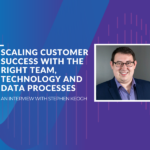The Data-Driven Economy
Cutting-edge Customer Intelligence and impactful customer insights are powerful competitive advantages in the new subscription economy.
With so much customer data available in enterprise organizations, a thorough and thoughtful approach to your customer intelligence efforts is more important than ever. In order to meet the demands of a competitive marketplace and deliver on your customers’ desired outcomes, you must create a holistic view of your customers as the basis of your Customer Success strategy. With the right customer data practices in place, you can understand the right messaging to send to your customers at the right time, tailor value outcomes to each customer and maximize value delivery across the customer journey.
In this article, we outline 4 crucial steps to turn your organization’s bits and bytes into actionable insights and harness the power of customer intelligence for unparalleled value realization.
1. Identify Key Customer Metrics & Gather Relevant Customer Data
Effective data collection and data management are the first steps to mastering customer intelligence. Your customer ecosystem is chock full of valuable customer data, both qualitative and quantitative, that can help you create a 360 degree view of your customers. In order to harness the power of all that valuable data, you must understand what metrics are most important to your customers and what Value-Based Outcomes they are trying to achieve. With your customer’s outcomes acting as your North Star, you can focus your efforts on collecting only the most relevant and meaningful data points.
Based on the metrics you identify, gather the most relevant data from the following sources:
- System of Customer Record – the system of customer record is where the most critical data about your customers lives. It holds contact details, transactional information, billing, contract details as well as behavioral data from every interaction your teams have with your customers.
- Product Data – in order to ensure your customers realize continued value from the use of your product, you need to monitor and collect product usage data, such as number of licenses, time spent in the product, feature adoption, and feature audits to see how customers interact with your product. The specific data points you collect, and the weighting you assign them, will depend on the outcomes your customers are trying to achieve.
- Customer Feedback – if used correctly, customer feedback can provide valuable information about customer sentiment. Direct feedback, through surveys or customer calls, are given on purpose or solicited so they may not be entirely accurate / representative of customer sentiment. Combining this type of feedback with other data sources and indirect customer feedback, through social listening and conversational AI, can provide a more holistic and complete picture of your customers.
2. Leverage Purpose-built Customer Intelligence Technology
Gathering all of this valuable customer data is meaningless unless you have a process for analyzing it and generating strategic actions to help you continuously improve and enhance value-driving activities. Assess what your customer data is telling you about what is going well and where there are opportunities for advancement and improvements in your people, processes and product.
The best and most effective way to generate meaningful insights from your data is through a Customer Success tool like Gainsight. By gathering all of your data into a CS technology solution, you can enable customer behavior modeling, forecasting and predictive customer analytics to help you spot trends and patterns. You can segment your customers and analyze past behavior to predict future actions, use intelligence gathered from churned customers to identify at-risk customers and determine where your customers are in comparison to their peers.
For the most cutting-edge customer intelligence, you can also incorporate advanced tools like Gong or Sturdy to harness the power of conversational intelligence and generate a 360-degree view of your customers.
3. Enable A Data-Driven Customer Success Strategy
Once you’ve analyzed your customer data, it’s time to take action on those insights and share them with all of your customer-facing teams. Democratizing access to customer intelligence is crucial to enhancing and streamlining customer value-driving activities where they are needed most across your organization. Creating and sharing accessible customer scorecards and dashboards will allow everyone in your organization to take action on your customer insights.
Your organization also needs a process for iteratively designing strategic actions that help you continuously improve and enhance your customer value-driving activities over time. The results of your analysis should drive changes in your roles, processes and systems. The insights can be used to generate personalized engagements with the customer, improved workflows that maximize efficiency and drive optimal value. For example, you could segment disengaged users and develop a re-engagement strategy to prevent churn or create tailored onboarding experiences based on your customers’ desired outcomes, make in-app suggestions and recommendations based on your customers’ preferences, and equip your team with the right tools to maximize customer value realization and optimize customer experience across your customer journey.
4. Measure The Impact of Your Customer Success Strategy
Customer intelligence isn’t meant to be a quick or one-time fix, but rather a long-term commitment to continuous improvement. Track the key metrics you identified in step 1, such as usage and adoption, to analyze your progress and the effectiveness of your CS strategy. As you review your customer data and your results, ask yourself; how is my customer doing and how can I get them doing more? This continuous loop of action, feedback data and iteration will not only improve your processes but will also advance your organization’s data-driven value delivery.
Data Drives Value
Organizations at the top of their game are designing their CS strategy and making informed business decisions using a strong Customer Intelligence model. Cutting-edge Customer Intelligence can help you identify opportunities and areas for improvement to help you create strategies that deliver exceptional customer value, ultimately driving unparalleled customer retention and expansion in your business.





